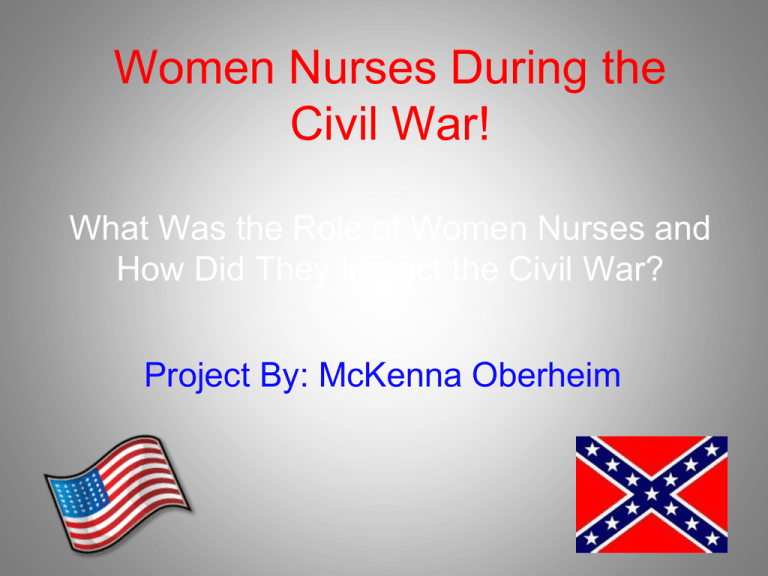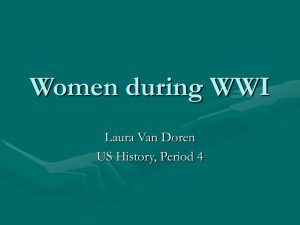Women Nurses During the Civil War!
advertisement

Women Nurses During the Civil War! What Was the Role of Women Nurses and How Did They Impact the Civil War? Project By: McKenna Oberheim What was the Role of Women During the Civil War? • At home, the women took over their husband’s jobs who were away in the army. • Women also helped gather the supplies that went to the army, worked in the kitchens, and worked in the laundries. • The nurses didn’t only help the wounded soldiers by giving them medicine. They also kept the soldiers in good spirits. For example, they read to them, prayed with them, talked to them, and fed them. • Women helped save many lives, and worked very hard! What was life like as a Civil war Nurse? • Before the civil war, mostly men were nurses, but that was soon to change. • Female nurses needed to be between 35 and 50, healthy, optimistic, and were willing to dress plainly. Over 3,000 nurses came to help. • At the beginning of the war, the Union decided they needed more medical help. They appointed Dorthea Dix the superintendent of the US Army Nurses in June of 1861. She was in charge of getting as many nurses to help the war efforts as possible. • Male army doctors didn't really like women helping out. The nurses would try to make the conditions in the hospital better for the wounded soldiers. Most of the time a doctor would ignore the request. If a doctor wouldn't listen, often nurses would just take matters into their own hands. • African-American nurses weren't treated as fairly, they were forced to work with the extremely sick patients, helped African soldiers, or did jobs that didn't require much skill. How did the Nurses Help in the Hospitals? • Between 3,000 and 8,000 women nurses served during the civil war, most of them were from the northern states. • People aren't exactly sure how many nurses served. • Many women didn't want their names recorded in the official books. • Many women also chose not to be paid because they just wanted to help people as much as they could. • Mrs. M. J. Boston once said to the surgeon she was working under, "I do not want any pay for my services. I only try to do all I can for the soldiers.“ • Since the nurses were used to taking care of their family, nursing the soldiers wasn't a strange thing to them like it was to the male surgeons. • Harriet Tubman was also a Civil War nurse aside from being a helper in the underground railroad. She also got a small military pension and an military funeral when she died in 1913. • Mary Ann Bikerdyke was very important in the care of the Confederate army. • Dr. Mary Edwards Walker who was the second woman to graduate from an American medical school, received the Congressional Medal of Honor but had it unfairly revoked by Congress when the changed the law on who could get the medal. How Did the Nurses Help in Hospitals? (2) • Many women heard about the bad conditions in military camps. They volunteered to work on battlefields, field hospitals, and make shift hospitals removed from battlefields. • Many army doctors disliked women nurses because they thought they were inexperienced and disorganized. • At the time of the Battle of Bull Run, there were ideas of how the injured soldiers would be helped. • Many hotels, houses, and any building the army could find was turned into a hospital. • Everyone thought that the war would end quickly so they thought that making a permanent hospital was unneeded. • If a soldier had an ailment that couldn't be taken care of quickly they were sent to a general hospital that gave more substantial care and took care of the soldier no matter what regiment they were. • While some troops were in Washington, some general hospitals were established to help them. • General hospital- Takes care of you no matter the regiment or side your on. • Regimental hospital- Only takes care of the people who belong to the regiment. How Did the Nurses Help in Hospitals? (3) • 2 out of 3 soldiers died of disease and infection. • Doctors had to drill holes in the floor of hospitals, so the blood could drain out. • The bullets at the time of the civil war were soft metal so they expanded and shattered the bone when you got shot. There was no other choice than to amputate since the bone was already too damaged and the doctors weren't skilled enough to do risky surgeries. • An unknown amount of confederate women helped out in hospitals too. • It was hard to be able to become a civil war nurse because the government didn't want to allow women to work outside the home. The men thought that the battlefield was no place for a woman. • About 620,000 men died. 360,000 union, 260,000 confederate in the war. How Did Nurses Help in Hospitals? (4) • In 48 months, about 10,000,000 cases of injury were treated by both confederate and union doctors. • The doctors did their best to help keep up with the injuries and tried to help as quickly as possible. • About 110,000 union men and 94,000 confederate men died from wounds. • The best care was found far behind the front lines in field hospitals. The people who were in stable condition were taken in unreliable, overcrowded ambulances to general hospitals in close by cities or towns. Medicines used During the Civil War! • Little was known about diseases. Like how to cure it, treat it, and stop it from spreading. • Surgeries were either very barbaric or didn't help you at all. • The wounded men were cared for by the underquilified, and inexperienced medical corps. • Before the war , An American medical student trained for two years or less in a school, and had virtually no on-site training. Even the most educated doctors still didn't know half of the things they should. • On the other hand, Europe's Medical students studied for 4 years, had plenty of on-site training, and knew what they were supposed to. • Before the war, Harvard didn't even own a stethoscope, or microscope! • When the war first began, the union army had 98 army doctors when the confederates only had 24. • By 1865, about 13,000 male union doctors and 4,000 confederate doctors worked in field hospitals and general hospitals. • But the men couldn’t do it alone! About 4,000 union women helped out in hospitals and tried very hard to help the wounded men. • It’s a common misconception that during the civil war there was no anesthetic, but there were medicines called Ether and Chloroform. Medicines used During the Civil War! (2) • The medical techniques during the civil war usually did you more harm then good. • If a soldier felt sick, he was given Calmoel which contained honey, chalk, and mercury. • The doctors didn't know that the medicine they were giving their patients were poisonous. The soldiers developed tooth decay, brain damage and digestive problems. • Chloroform was an anesthetic that was invented in the 1840's. How the Nurses Dressed! • Their dresses had to be black or brown. • They had to be either a solid color or have a pattern so the stains couldn’t be seen. • The dresses had to be made of cotton so they could be washed easily. • The nurses weren’t allowed to wear hoopskirts because they were too big to fit through the hospital aisles. • Dorthea Dix, superintendent of Army nurses, placed regulations on what the nurses could or could not wear. • "All nurses are required to be plain looking women, Their dresses must be brown or black, with no bows, no curls, no jewelry, and no hoop-skirts.“ Dorthea stated. A Nurse’s Dress! Clara Barton! Her Work On The Battlefields • She gathered supplies to help the men during the war. • She decided that she needed to help the men who were on the battlefield because most of the distress was there. • She asked the government for a long time to let her work on a battlefield and at field hospitals and they finally allowed her. • She followed the battle of Cedar Mountain and brought supplies to a field hospital. • She also kept the men's spirits high. She read to them talked to them, prayed with them, and wrote letters. • At the battle of Antietam, she told her drivers to follow the cannon and she ended up getting there before the unit physicians. Clara Barton! (2) • Following the battle of Cedar Mountain in northern Virginia in August 1862, she appeared at a field hospital at midnight with a wagon-load of supplies drawn by a four-mule team. The surgeon on duty, overwhelmed by the human disaster surrounding him, wrote later, “I thought that night if heaven ever sent out a[n] . . . angel, she must be one—her assistance was so timely.” Thereafter she was known as the “Angel of the Battlefield” as she served the troops at the battles of Fairfax Station, Chantilly, Harpers Ferry, South Mountain, Antietam, Fredericksburg, Charleston, Petersburg and Cold Harbor. • In the face of danger, she wrote, “I always tried . . . to succor the wounded until medical aid and supplies could come up—I could run the risk; it made no difference to anyone if I were shot or taken prisoner.” • In the month before his assassination, President Abraham Lincoln wrote: “To the Friends of Missing Persons: Miss Clara Barton has kindly offered to search for the missing prisoners of war. Please address her . . . giving her the name, regiment, and company of any missing prisoner.” Barton established the Office of Correspondence with Friends of the Missing Men of the United States Army and operated it out of her rooms in Washington for four years. She and her assistants received and answered over 63,000 letters and identified over 22,000 missing men. Years later, Red Cross established a tracing service, one of the organization’s most valued activities today. • After Barton helped raise the U.S. flag over the Andersonville grounds at their dedication in 1865, she wrote, “I ought to be satisfied. I believe I am.” Coming events were to show, however, that she would never be satisfied except by responding again and again to the call of human need. Clara Barton! (3) The Red Cross • When she was 60, She founded the American Red Cross. • Chester Arthur signed the treaty for the American Red Cross in 1882, a few days later congress approved it. • The Red Cross named it The American National Red Cross, then changed it to The American Red Cross in 1893. • Congress gave the Red Cross charters in 1900 and 1905 • The Red Cross was devoted to helping disaster victims for the first 20 years. • The Red Cross flag first flew in 1881 when she asked people to donate supplies to the victims of a major forest fire in Michigan. • In 1884, she asked boats to go up and down the Ohio and Mississippi rivers to help flood victims. • In 1889, she aided the survivors of the dam break in Johnstown, Pennsylvania that causes over 2,000 deaths. Project Summary! • Women played a very important role during the Civil War. • They took the place of their husbands on such short notice. • They were independent and took care of their families all by themselves! • Even with the limited technology the nurses, found a way to help the wounded soldiers. • Being a Civil War nurse was the one of the first opportunities for a woman to have a job. • They helped save many lives and brought comfort to soldiers during a tough time. Bibliography! • http://www.carlisle.army.mil/ahec/AHM/civilwarimagery/Civil_War_N urses.cfm • http://cwnurses.tripod.com/. N.p., n.d. Web. 7 Jan. 2013. • http://www.civilwaracademy.com/civil–war–women.html. N.p., ... • http://www.hektoeninternational.org/Journal_NursingduringCi... • Billings, John D. Hardtack and Coffee. N.p.: n.p., 1993. Pri... • Oberheim, Arthur. Personal interview. 10 Jan. 2013. • http://cwnurses.tripod.com/how.html. N.p., n.d. Web. 10 Jan... • http://www.civilwaracademy.com/civil–war–medicine.html. N.p... • http://www.civilwarhome.com/civilwarmedicine.htm. N.p., n.d... • http://ts3.mm.bing.net/th?id=H.4889623545184530&pid=1.7&w=239 &h=148&c=7&rs=1 Final Notes! • I chose the gray background and blue letters after the Union and Confederate uniforms. • I got all my pictures from http://ts3.mm.bing.net/th?id=H.48896235451845 30&pid=1.7&w=239&h=148&c=7&rs=1 • Thanks for watching!





